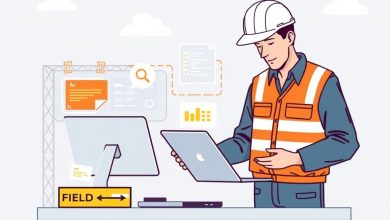Field Service Management for Remote Asset Management

Introduction
Field Service Management (FSM) has evolved significantly over the years, particularly with the advent of remote asset management technologies. This evolution has transformed how businesses manage their assets and deliver services in the field. In this article, we’ll explore the concept of FSM for remote asset management, its benefits, challenges, and best practices.
- What is Field Service Management?
- The Rise of Remote Asset Management
- Benefits of Field Service Management for Remote Asset Management
- Challenges in Implementing Field Service Management for Remote Asset Management
- Best Practices for Implementing Field Service Management for Remote Asset Management
- Case Study: XYZ Corporation’s Journey to FSM for Remote Asset Management
- Conclusion
What is Field Service Management?
Field Service Management refers to the process of managing and coordinating work activities performed outside the office environment. It involves scheduling appointments, dispatching technicians, managing inventory, and tracking customer interactions. Traditionally, FSM relied heavily on manual processes and paper-based systems. However, with advancements in technology, especially in the realm of Internet of Things (IoT), FSM has become more efficient and data-driven.
The Rise of Remote Asset Management
Remote asset management is a subset of FSM that focuses on monitoring and maintaining assets located away from the central office. With the proliferation of connected devices and cloud computing, it has become possible to track and manage assets remotely. This approach offers numerous advantages, including improved efficiency, reduced costs, and enhanced customer satisfaction.
Key Components of Remote Asset Management
- Real-time tracking: Enables continuous monitoring of asset location and status.
- Predictive maintenance: Uses data analytics to predict potential equipment failures before they occur.
- Automated alerts: Sends notifications for scheduled maintenance or unexpected issues.
- Remote diagnostics: Allows technicians to diagnose problems without physically visiting the site.
- Inventory management: Tracks spare parts and consumables in real-time.
Benefits of Field Service Management for Remote Asset Management
Implementing FSM for remote asset management can bring significant benefits to organizations:
- Improved operational efficiency: By automating routine tasks and providing real-time insights, FSM helps streamline operations.
- Enhanced customer experience: Faster response times and better communication lead to increased customer satisfaction.
- Cost reduction: Reduced travel time and optimized resource allocation result in lower operational costs.
- Data-driven decision making: Access to accurate, real-time data enables better strategic planning and forecasting.
Challenges in Implementing Field Service Management for Remote Asset Management
Despite the numerous advantages, there are several challenges that organizations may face when implementing FSM for remote asset management:
- Initial investment: Setting up a robust FSM system requires significant upfront investment in hardware, software, and training.
- Integration complexities: Ensuring seamless integration between existing systems and new FSM solutions can be challenging.
- Security concerns: Managing remote assets increases the risk of cyber attacks and data breaches.
- Change management: Adopting new technologies often requires cultural shifts within the organization.
Best Practices for Implementing Field Service Management for Remote Asset Management
To overcome the challenges and maximize the benefits of FSM for remote asset management, consider the following best practices:
- Conduct thorough needs assessment: Understand your specific requirements and current pain points before selecting a solution.
- Choose the right technology: Select FSM solutions that integrate well with your existing systems and offer scalability for future growth.
- Invest in employee training: Ensure that all staff members understand the new system and its capabilities.
- Establish clear policies and procedures: Develop standardized operating procedures to ensure consistency across teams.
- Regularly review and optimize: Continuously assess the effectiveness of your FSM implementation and make necessary adjustments.
Case Study: XYZ Corporation’s Journey to FSM for Remote Asset Management
XYZ Corporation, a leading provider of HVAC services, was facing challenges in managing its fleet of service vehicles and technicians. They decided to implement a comprehensive FSM solution for remote asset management.
Implementation Process
- Needs Assessment: XYZ conducted a detailed analysis of their current processes and identified areas for improvement.
- Solution Selection: After evaluating various options, they chose a cloud-based FSM platform that offered real-time tracking and predictive maintenance features.
- System Integration: The new FSM system was integrated with their existing CRM and accounting software.
- Training: All technicians were trained on the new system, focusing on its key features and benefits.
- Rollout: The new FSM solution was gradually rolled out across different regions, starting with a pilot group.
Results
After six months of implementation, XYZ Corporation reported significant improvements:
- A 30% reduction in response times
- A 25% decrease in fuel consumption due to optimized routing
- A 15% increase in first-time fix rates
- A 20% reduction in overall operational costs
Conclusion
Field Service Management for remote asset management represents a powerful combination of technology and business strategy. As the industry continues to evolve, organizations that embrace these innovations will be better positioned to compete in today’s fast-paced market. While challenges exist, the benefits of improved efficiency, enhanced customer satisfaction, and cost reduction make the investment worthwhile.
By understanding the components, benefits, challenges, and best practices of FSM for remote asset management, organizations can make informed decisions about implementing such solutions. Whether you’re a small startup or a large enterprise, embracing these technologies can help transform your field service operations and drive success in the competitive landscape of modern business.




